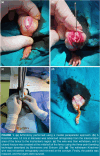The effects of gabapentin and pregabalin on fracture healing: A histological, radiological, and biomechanical analysis
- PMID: 39719918
- PMCID: PMC11734844
- DOI: 10.52312/jdrs.2025.2042
The effects of gabapentin and pregabalin on fracture healing: A histological, radiological, and biomechanical analysis
Abstract
Objectives: This study evaluated the impact of different doses of gabapentin and pregabalin on fracture healing in a rat femoral shaft model, with histological, radiological, and biomechanical assessments.
Materials and methods: Seventy male Wistar albino rats were divided into five groups: control, low-dose gabapentin (GBP-L, 300 mg/day), high-dose gabapentin (GBP-H, 3600 mg/day), low-dose pregabalin (PRG-L, 150 mg/day), and high-dose pregabalin (PRG-H, 600 mg/day), based on human equivalent doses. Bilateral femoral fractures were induced; the right femurs were prepared for radiological examination using microtomography, followed by histological analysis, whereas the left femurs were allocated for biomechanical testing. Drug administration began three weeks preoperatively and continued until sacrifice at either two or four weeks. Histological assessments included inflammation and transformation scoring and microtomography-measured callus volume. Biomechanical testing assessed maximum force and stiffness.
Results: At the fourth week, inflammation levels were significantly higher in the GBP-H, PRG-L, and PRG-H groups compared to control (p<0.01, p<0.05, and p<0.01), while transformation scores were significantly lower in these groups (p<0.01, p<0.05, and p<0.001). Low-dose pregabalin showed a borderline transformation difference (p=0.051). Microtomography analysis showed that the GBP-H group had significantly reduced callus volume versus control by the second week (p<0.01), persisting at a lower significance by week four (p<0.05). By the fourth week, PRG-H also had reduced callus volume (p<0.05). Maximum force values by the fourth week were significantly lower in the GBP-L, GBP-H, and PRG-H groups compared to control (p<0.05 for GBP-L; p<0.01 for GBP-H and PRG-H).
Conclusion: These findings suggest that these drugs, particularly with their high-dose applications, may lead to prolonged inflammation and hinder fracture healing by reducing callus volume and biomechanical integrity, potentially disrupting the transition from the inflammatory to reparative phases of healing.
Conflict of interest statement
Figures






Similar articles
-
Effects of different vardenafil doses on bone healing in a rat fracture model.Jt Dis Relat Surg. 2021;32(2):313-322. doi: 10.52312/jdrs.2021.72. Epub 2021 Jun 11. Jt Dis Relat Surg. 2021. PMID: 34145806 Free PMC article.
-
Comparison of the effects of gabapentin and pregabalin on wound healing in rats.Int Wound J. 2016 Oct;13(5):748-53. doi: 10.1111/iwj.12364. Epub 2014 Oct 28. Int Wound J. 2016. PMID: 25348659 Free PMC article.
-
Irisin and its role in fracture healing: A comparative study with hyaluronic acid and platelet-rich plasma in a rat model.Jt Dis Relat Surg. 2025 Apr 5;36(2):328-339. doi: 10.52312/jdrs.2025.2097. Epub 2025 Apr 5. Jt Dis Relat Surg. 2025. PMID: 40235411 Free PMC article.
-
Pregabalin and gabapentin for the treatment of sciatica.J Clin Neurosci. 2016 Apr;26:1-7. doi: 10.1016/j.jocn.2015.05.061. Epub 2015 Nov 26. J Clin Neurosci. 2016. PMID: 26633090 Review.
-
Alpha2delta ligands, gabapentin, pregabalin and mirogabalin: a review of their clinical pharmacology and therapeutic use.Expert Rev Neurother. 2016 Nov;16(11):1263-1277. doi: 10.1080/14737175.2016.1202764. Epub 2016 Jul 7. Expert Rev Neurother. 2016. PMID: 27345098 Review.
Cited by
-
Functional mechanism and clinical implications of lncRNA NEAT1 in traumatic fractures and their correlation with delayed healing.J Orthop Surg Res. 2025 Aug 9;20(1):752. doi: 10.1186/s13018-025-06152-w. J Orthop Surg Res. 2025. PMID: 40783548 Free PMC article.
References
MeSH terms
Substances
LinkOut - more resources
Full Text Sources
Medical
Research Materials

